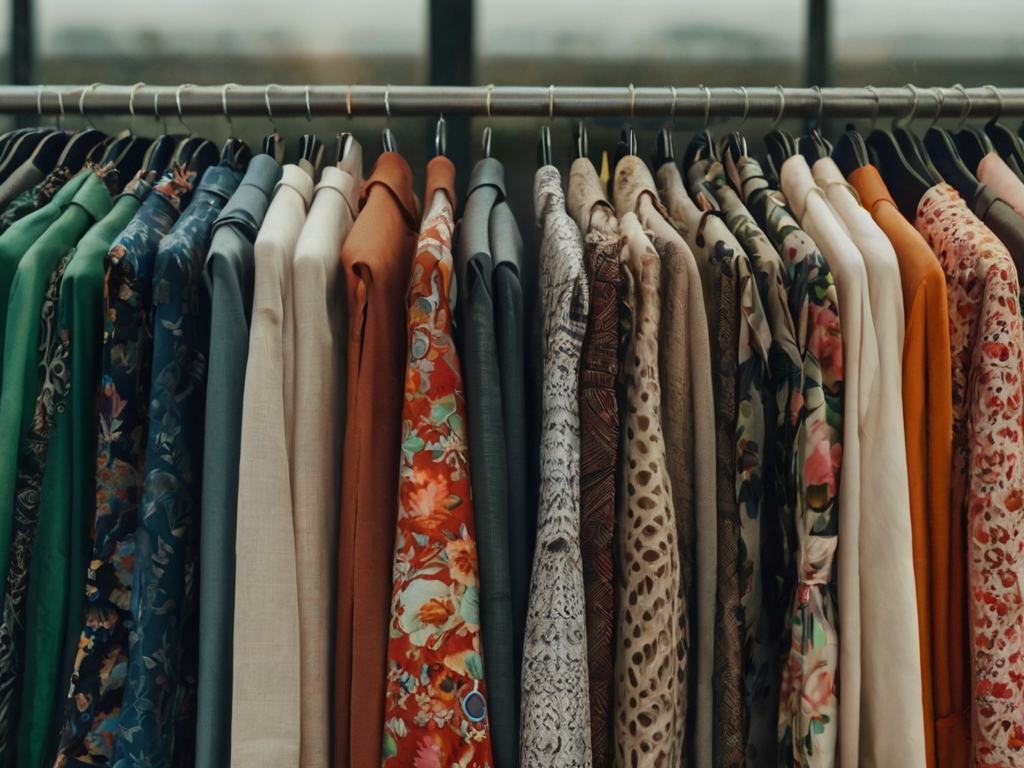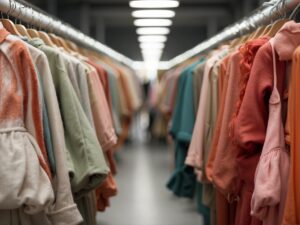Fast fashion has become an apparel industry trend, with firms rapidly mass-producing low-cost goods. Fast fashion, on the other hand, is hurting the environment. The use of chemicals and synthetic materials in fast fashion manufacture causes pollution and depletion of natural resources. Textile workers are notorious for being exploited, with low wages and bad working conditions. Here we will discuss the environmental impact of fast fashion. As well as its social consequences and mitigation measures.
History of fast fashion
Fast fashion began in the 1960s when clothing began to be mass-produced at a rapid pace. With the development of popular brands such as Zara and H&M in the 1990s, fast fashion became a global phenomenon. These businesses intended to offer attractive apparel at a reasonable price.
Fast fashion is criticized because of its negative implications. Because of the industry’s emphasis on mass production. This speedy fashion wasn’t all sunshine and rainbows. People making the clothes often didn’t get paid enough, and the planet took a big ouch from all the stuff being made. Each year around 92 million tons of materials waste are produced. Mountains of old clothes piled up, horrible.
Why fast fashion is popular
Wonder you’re scrolling through your phone, and suddenly BAM! There’s a picture of the coolest shirt ever, the one your favorite singer wore on stage. You gotta have it! But it’s at the fancy store downtown, and your piggy bank is on a strict diet.
Fast fashion comes to the rescue, like a superhero with a magic wand! It turns runway trends into clothes you can find at the corner store, for the price of a candy bar. It’s like having a birthday surprise every week, with new styles popping up faster than popcorn in a movie.
Think of it like this: regular clothes are like turtles, they take ages to make and last for years. Fast fashion clothes are like rabbits, zooming from factories to stores in a blink. They’re not always the best quality. But they’re fun and cheap, letting you be a mini fashion star without breaking the bank.
That’s why fast fashion is so popular. It’s like a playground for your closet, letting you experiment with all the latest looks without spending a fortune. But remember, with great clothes comes great responsibility. Fast fashion can be messy for the planet and unfair to the people who make it. So next time you’re on a shopping spree, choose a few key pieces you’ll love for a long time!
Ultimately, the choice is yours to be a fast fashion butterfly, flitting from one trend to the next. Or a slow and steady turtle, building a wardrobe that lasts. Just remember, whatever you choose, wear it with confidence and rock your unique style.
The environmental impact of fast fashion
Think of our planet as a giant, sparkling piggy bank full of precious resources like water and clean air. Fast fashion is like a sneaky piggy bank thief. It’s taking big gulps of water and leaving behind yucky pollution.
Here’s the scoop:
- Making one cotton t-shirt guzzles up over 700 gallons of water, enough to fill a bathtub 3 times. Fast fashion churns out millions of clothes every year. It’s leaving our planet feeling parched.
- Dyeing those cool colors you love pollutes rivers and streams with nasty chemicals. Imagine dumping paint in your favorite swimming spot.
- Most fast fashion clothes are made from cheap materials that fall apart quickly, ending up in landfills like mountains of forgotten clothes. It’s like throwing away your lunchbox every day.
- Lots of fast fashion uses plastic fibers, which shed tiny bits called microplastics that end up in oceans. It’s harming fish and even getting into our food!
So, what can we do?
- Choose clothes made from sustainable materials like recycled fabrics or organic cotton. They might cost a bit more, but they’re kinder to the planet and last longer. Think of it like investing in a piggy bank that never runs dry!
- Take care of your clothes so they last longer. Wash them less often, air-dry them when possible, and mend any rips or tears. Imagine hugging your favorite toy instead of throwing it away!
- Give pre-loved clothes a new life by shopping at thrift stores or swapping with friends. It’s like finding hidden treasure in someone else’s piggy bank.
- Remember, even compact changes can make an incredible difference. By being mindful of the outfits we buy and wear, we can help keep our planet sparkling and healthy for everyone.
The production process of fast fashion
Picture spies zooming around, not looking for bad guys. But for the hottest styles – what celebs are wearing, what’s popping on social media. They whisper these secrets to the fashion designers. Designers whip up sketches faster than a cheetah, turning those trends into cool outfits. Think of it like drawing pictures with lightning bolts. Huge machines chomp up mountains of fabric, cutting and stitching like robots on a sugar rush. It’s like a fabric dance party but with needles and thread instead of disco balls.
Clothes take a dip in colorful baths, turning plain white into tie-dye dreams or neon explosions. Just be careful, these baths aren’t always friendly to our rivers and streams. Clothes zip past inspectors, but sometimes mistakes slip through like sneaky ninjas. Not all fast fashion clothes are built to last, so be gentle with them!
Trains, trucks, and planes zoom like rockets, delivering those fresh clothes to stores faster than you can say “shopping spree!” They’re like fashion superheroes with jetpacks. Finally, the clothes land in stores, tempting us with their trendy styles and low prices. It’s like a candy store for clothes. But remember, sometimes cheap treats aren’t the healthiest choice.
The textile industry and it’s impact on the environment
Think of a messy room, except instead of toys, it’s chemicals and waste. The textile industry uses tons of water, energy, and harmful substances to make our clothes. It’s like a thirsty giant, guzzling resources and leaving behind a trail of pollution. Rivers choke on dyes, and fields suffer from chemical fertilizers. And landfills overflow with discarded clothing. It’s not a pretty picture.
Now, envision this messy room getting even messier. That’s what fast fashion does. We crave new clothes all the time, like candy bars we can’t resist. But every new shirt, every trendy skirt, means more resources used. More pollution is dumped, and more mountains of unwanted clothes. It’s a never-ending cycle of “buy, wear, toss,” and our planet is paying the price.
It’s like throwing a birthday party every week but forgetting to clean up the mess. But wait, we can save the day. By choosing clothes made from recycled materials, and shopping at thrift stores. And taking care of what we have, we can break the cycle. Let’s wear our clothes with pride, knowing we’re doing our part for a cleaner, greener planet.
The use of synthetic materials in fast fashion
Let’s talk about your favorite comfy tee, but instead of soft cotton, it’s made of plastic. That’s the world of synthetic materials, the building blocks of much of fast fashion. These fabrics, like polyester and nylon, might sound fancy. But their impact on our planet is anything but horrible.
Let’s face it, fast fashion is tempting. New trends every week, rock-bottom prices. But those synthetic materials used to make them come with a hidden cost. They’re often made from oil, a non-renewable resource that won’t be magically restocked like cotton plants. They’re not exactly recycling buddies either. When they finally give up the ghost (which takes centuries). They break down into tiny plastic bits that pollute our soil and oceans, harming wildlife.
The fast fashion cycle of “buy, wear, toss” is a recipe for disaster. We churn through mountains of clothes made from these harmful materials. It’s leaving a trail of pollution and waste in our wake.
The dyeing process and it’s impact on the environment
A significant component of the apparel manufacturing process. When you’re turning a plain white shirt into a rainbow explosion of colors! That’s dyeing, a crucial part of making clothes. But in fast fashion, this process gets a bit messy. The dyes used can be like sneaky villains, harming both the workers who make the clothes and the environment.
Rivers become colorful traps, choking on dye waste that harms fish and other creatures. Plus, dyeing guzzles water, a precious treasure like a piggy bank filled with diamonds. Imagine all that water draining away because of too many new clothes – not cool for communities who struggle for every drop. So, remember the hidden story of dyeing next time you see a dazzling outfit.
The amount of water used in the production of fast fashion
Water is an important resource that is dying out. Dream up your favorite comfy tee, but making it takes enough water to fill a bathtub over 700 times. It’s estimated around 2,700 liters of water. That’s the secret of fast fashion – it drinks water like a thirsty giant. Every new top, every trendy pair of jeans, gulps up resources that could quench human thirst for years.
This water-guzzling isn’t just annoying, it’s dangerous. In places already struggling with dry spells. Fast fashion acts like a bully, stealing water needed for communities and farms. This isn’t cool for anyone, not the farmers trying to grow food, not the families worried about running faucets. This production isn’t sustainable, and it’s creating destruction around the globe.
The disposal of textile waste
The disposal of textile waste is one of the most critical concerns caused by fast fashion. Synthetic clothing can take decades to disintegrate. Also, It’s releasing toxic substances into the environment in the meantime. Waste disposal in landfills increases greenhouse gas emissions and pollutes soil and water.
The social impact of fast fashion
Fast fashion might be tempting with its low prices and flashy trends. But behind the scenes, it can be like a superhero movie with some not-so-super villains. The people who make our clothes often work long hours for little pay, in unsafe conditions.
It’s like they’re stuck fighting a never-ending battle, stitching clothes so we can rock the latest styles. Remember, every trendy top or cute skirt has a story. Because true style means looking good and feeling good about where our clothes come from.
Exploitation of workers in the fast fashion industry
Now picture the people who made it, hunched over sewing machines in hot, crowded factories for tiny paychecks. Another hidden secret of fast fashion. Trendy clothes are made on the backs of unfairly treated people.
These workers, often in developing countries, are like real-life superheroes, stitching up the latest styles at lightning speed. But their powers come at a big cost:
- Low wages: They barely earn enough to feed their families, let alone enjoy the clothes they make.
- Long hours: They toil for endless days, sometimes even overnight, just to keep up with our demand for cheap new clothes.
- Unsafe conditions: Cramped factories, faulty machinery, and lack of safety gear put their health and even lives at risk.
- Abuse: In some cases, they face verbal or even physical mistreatment from their bosses.
It’s like a never-ending race to keep up with our ever-changing fashion desires. And these amazing people are the ones left running on empty. But we can be the change.
The low cost of labor and it’s impact on working conditions
Your favorite outfit can be so cheap you could buy three! But behind that low price is a hidden story. This race against the clock for cheap clothes has some rough consequences:
- Exhaustion marathon: These clothes cost workers their health. Tired from endless shifts, they risk accidents and even getting sick. Imagine running a marathon every day, just to make a living.
- Safety shortcuts: With barely enough money for food, safety becomes a threat to the workers. Cramped factories with broken machines can be dangerous if you can’t protect yourself.
- Stress overload: Worrying about rent and food adds to the pressure. The cost of cheap clothes is often paid in workers’ peace of mind and well-being.
Child labor in the production of fast fashion
Have you ever wondered who makes the clothes you wear? Sometimes, the answer is children. Yep, kids as young as 5 are sometimes forced to work long hours in hot. Unsafe factories make the trendy clothes we see in stores.
These hidden helpers:
- Miss out on school and playtime.
- Work in dangerous conditions that can hurt them.
- Get paid almost nothing for their hard work.
It’s not right! We can all do our part to stop child labor by:
- Buying less clothing. The more we buy, the more clothes need to be made, and the higher the chance of child labor being involved.
- Choosing clothes made ethically. Look for brands that are committed to using fair labor practices.
- Asking questions. If you’re not sure where your clothes came from, ask the store or brand.
The impact of fast fashion on climate change
Think about your favorite hoodie. But did you know that making just one hoodie uses enough water to fill 15 bathtubs? Whoa! That’s just one tiny piece of the fast fashion puzzle. This industry churns out clothes at breakneck speed, and the planet pays the price.
Every year, fast fashion spews out more greenhouse gases than all the international flights and maritime shipping combined! That’s like having a million cars constantly zooming around. It’s filling the air with pollution that warms our planet. Yikes!
But it’s not just the air that suffers. Fast fashion guzzles water like a thirsty camel, slurping up enough to fill 32 million Olympic-sized swimming pools every year! And all that dyeing and processing leaves rivers choked with colorful chemicals. It’s making them sad and unhealthy for fish and plants.
The carbon footprint of fast fashion
Fast fashion items have a significant carbon footprint. It’s because of its high volume of production. Dream up your closet filled with clothes, but each item carries a hidden backpack of invisible pollution. Clothes churn out like popcorn, but making them takes tons of energy, like powering up a whole city. Fast fashion accounts for more pollution than planes and ships combined.
It’s like having millions of cars running non-stop, filling the air with bad stuff that warms our planet. The fashion industry is responsible for around 10% of global carbon emissions. Every trendy tee needs water – more than you’d use in 15 baths! And those fancy fabrics often come from oil, like plastic, leaving dirty footprints along the way.
The environmental impact of fast fashion on natural resources
This earth is a giant treasure chest of water, air, and healthy land. Fast fashion loves grabbing from that chest, but doesn’t always put things back!
Here’s how it takes:
- Land: Growing cotton for all those t-shirts needs space, sometimes leading to cutting down forests and squeezing animals out of their homes.
- Water: Making clothes gulps down water like a thirsty elephant! And guess what? It often gets dumped back dirty, hurting rivers and fish.
- Air: Smoke from factories and fumes from trucks carrying clothes fill the air like bad breath, not good for our lungs or the planet.
- Animals: When we only farm one kind of plant (monoculture!), bugs and birds who like variety lose their homes and food.
But we can be eco-heroes! Buy less, wear clothes longer, and find cool second-hand treasures. Brands can join the party by choosing kinder materials and making clothes that last.
Fast fashion solutions
Fast fashion might feel fun and cheap, but it’s like leaving messy wrappers after a party. It’s not perfect at all. But we shouldn’t fear at all. Here are some amazing solutions:
1. Shop smarter:
- Do you need that new top? Maybe your bestie has one you can borrow (and swap outfits with later!).
- Thrift stores are treasure troves for unique finds, often at a fraction of the price. Plus, you’ll be giving clothes a new life!
- Invest in a few well-made pieces that you’ll love for years, instead of tons of trendy throwaways.
2. Wear with care:
- Wash less often and air dry to save water and energy. Plus, your clothes will last longer!
- Got a ripped seam? No worries! A little stitch can work wonders.
- Clothes swap parties are a fun way to refresh your wardrobe and bond with friends.
3. Choose wisely:
- Look for those brands using recycled materials or committed to ethical practices.
- Choose clothes made from cotton, linen, or other natural materials, which are kinder to both the planet and your skin.
- Give local designers and ethical brands a chance. They often create amazing pieces with love for the planet woven into every stitch.
Always remember, that every choice you make counts. By rocking eco-friendly fashion, you’re not just looking amazing. You’re helping protect our beautiful planet. So be a green fashion sensation, and show fast fashion the door.
Conclusion
In conclusion, Fast fashion might be tempting. But it’s like leaving mountains of empty candy wrappers after a party – not cool for our planet. Rock your clothes twice as long and share styles with friends. And hunt for hidden treasures at second-hand shops. Think of it like a fun fashion adventure.
Brands can join the party too, by choosing kinder materials and making clothes that last, not just for one season. Together, we can show fast fashion the door and build a new fashion world where looking good and feeling good for the planet go hand-in-hand. It’s time to turn our closets into eco-powerhouses, one recycled outfit at a time.


